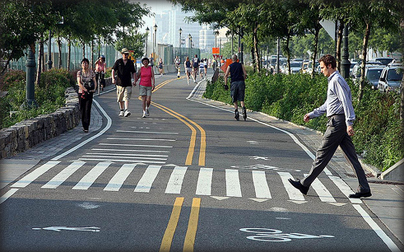Walkability makes cities greener
With the urban population swelling the world over, it makes sense
that we start - or go back to - creating cities for people too. People
are a city's principal raison d'etre, so cities should be designed or
redesigned to address one aspect that will make them greener -
Walkability.
In mega cities such as Manila or Jakarta, it is crucial to have
sustainable, well-planned, clean and affordable public transport.
 However, it must be remembered that while making a city more walkable
makes it more livable and attractive, it also needs sustainable public
transport. But what is walkability? However, it must be remembered that while making a city more walkable
makes it more livable and attractive, it also needs sustainable public
transport. But what is walkability?
Is a city's availability of sidewalks enough to say it is walkable?
Does adding a few green spaces make it walkable? How about disability
access and safety? Could a high-density city with good accessibility
between home, retail and work areas by foot or public transport still be
described as walkable if there remains a high incidence of pedestrians
being hit by cars each day?
Travel and mobility should be a pleasant part of the landscape,
rather than forcing pedestrians to traverse multiple lanes of
fast-moving traffic. In Asia, many cities have paid little attention to
the demand and availability of pedestrian facilities.
In the Philippines, while about two million people own private
vehicles, the remaining 98 million who cannot afford cars or choose not
to have one have no other choice but to walk, cycle or take public
transport. Unfortunately, a lack of proper sidewalks is compounded by
unsafe, inconvenient, crowded and unreliable public transportation. This
lack of walkability hardly makes any city inclusive, green, livable or
sustainable. A city designed with the human foot in mind is also
designed with people's needs in mind.
Increased walkability helps improve resource responsibility, safety,
physical fitness and social interaction. Such interaction leads to
communities that are thriving, livable and sustainable, providing
residents with safe transportation choices and improved quality of life. |

